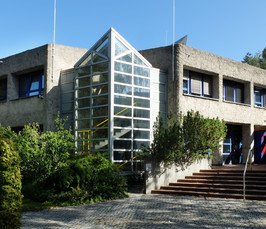The Key Role of Lattice Anharmonicity for Heat and Charge Transport in Solids: Fundamental Concepts, Novel Methods, and Relevant Applications
A Joint Seminar of the NOMAD Laboratory and of the Ma group
- Online Seminar
- Date: Oct 29, 2020
- Time: 10:15 AM (Local Time Germany)
- Speaker: Dr. Christian Carbogno
- Fritz-Haber-Institut, NOMAD Laboratory
- Location: Join the webinar: https://us02web.zoom.us/j/87275903448?pwd=V0dzZWl1T3EvNjBCMWxKT0h1REJNUT09
- Room: Webinar ID: 872 7590 3448 I Passcode: NOMAD
- Host: NOMAD Laboratory

To
understand the microscopic mechanisms that drive or hinder heat and charge
transport in the required functional materials under actual operational temperatures
above 300 K, a quantitatively reliable description of the interatomic
interactions is essential. For this purpose, we explore material space using a
recently developed measure for anharmonicity [4], i.e., a metric for the strength of those interatomic
interactions that are neglected in the harmonic approximation. This reveals
that largely harmonic materials are the exception to the rule under realistic
conditions and that strong anharmonic effects that cannot be accounted for
within the harmonic picture –not even by perturbative corrections on top of it–
are not uncommon at all. Clearly, ab
initio molecular dynamics (aiMD) is the computational technique of
choice to overcome these hurdles, since it correctly accounts for all orders of
anharmonicity. Its application in the context of heat and charge transport is,
however, far from straightforward and requires specific conceptual developments
and algorithmic adaptations. To exemplify, we discuss how the derivation of a
gauge-independent vibrational heat flux definition enables to exploit the
fluctuation-dissipation theorem and to perform ab initio Green-Kubo calculations of lattice thermal conductivities
up to the melting point [5]. In
turn, this allows a qualitative understanding of the mechanisms active under
these thermodynamic conditions and opens up opportunities for tailoring
them, e.g., to improve the insulation of thermal-barrier coatings in
airplane turbines [6]. Furthermore,
we discuss how the presented concepts can be generalized so to not only capture
vibrational couplings between nuclei, but also vibronic ones, i.e., the ones between
electronic and nuclear degrees of freedom. As demonstrated for the perovskite
SrTiO3, perturbative expansions also break down for the description
of vibronic effects, leading to a severe overestimation of the electronic
band-gap at elevated temperatures [7].
Eventually, we discuss the implications of these findings for the assessment of
charge transport and explore routes towards a non-perturbative theory of electronic
charge and heat conductivities in semiconductors. This then enables a fully
parameter-free, quantitative theory of thermoelectricity.
[1] A. G. Evans, D. R. Clarke, and C. G. Levi, J. Eur. Ceram. Soc. 28, 1405 (2008).
[2] G. J. Snyder and E. S. Toberer, Nature Materials 7, 105 (2008).
[3] Y. Liu, Y. Zhu, and Y. Cui, Nature Energy 4, 540 (2019).
[4] F. Knoop, T. A. R. Purcell, M. Scheffler, and C. Carbogno, Phys. Rev. Mat. 4, 083809 (2020).
[5] C. Carbogno, R. Ramprasad, and M. Scheffler, Phys. Rev. Lett. 118, 175901 (2017).
[6] C. Carbogno, C. G. Levi, C. G. Van de Walle, and M. Scheffler, Phys. Rev. B 90, 144109 (2014).
[7] M. Zacharias, M. Scheffler, and C. Carbogno, Phys. Rev. B 102, 045126 (2020).